2013 IEEE North Jersey Advanced Communications Symposium – Sep. 21, 2013
First Annual IEEE North Jersey Advanced Communications Symposium is a Great Success!
The 2013 IEEE North Jersey Advanced Communications Symposium (NJACS) was held at the Babbio Center, Stevens Institute of Technology, in Hoboken, NJ, on Saturday September 21, 2013. The symposium consisted of eight invited presentations and a parallel poster session with 18 posters from students from ARDEC, CUNY, FDU, NJIT, NYU-Poly, Princeton, Rutgers-WINLAB, and Stevens Institute of Technology. The symposium was well attended, with 84 participants from New Jersey and New York.
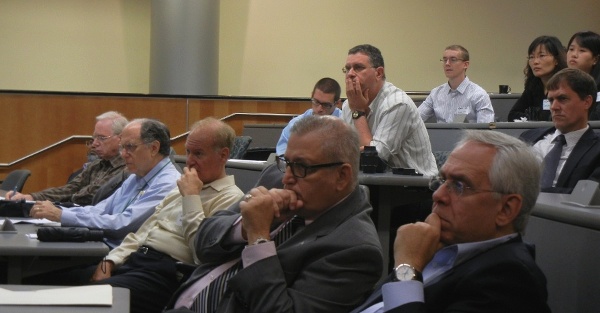
Vice-Provost Constantin Chassapis (front-right) and Section Chair Russell Pepe (front-center) are among the attendees at NJACS.
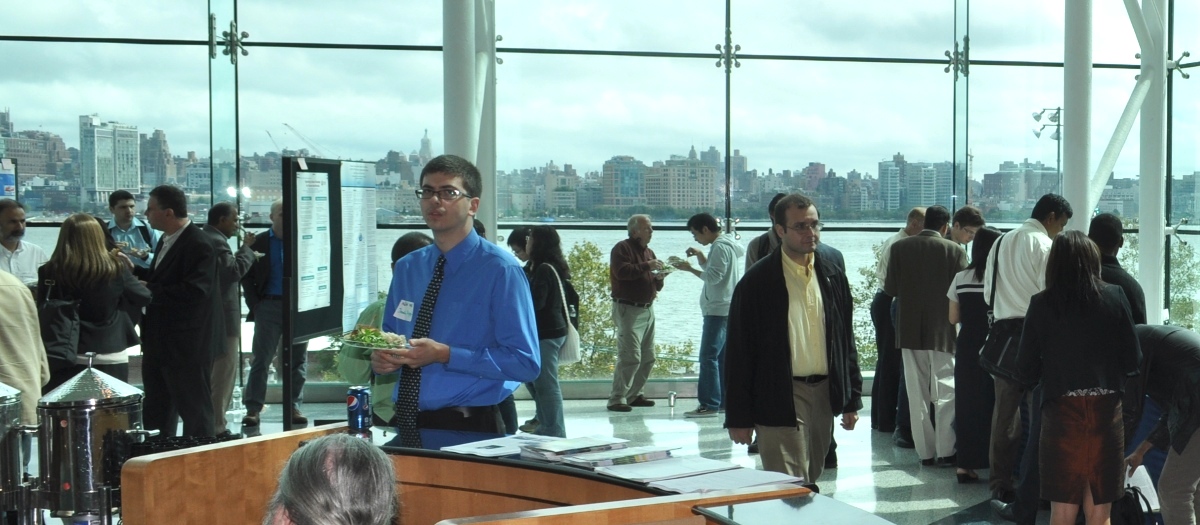
Symposium participants and poster presenters in the atrium.
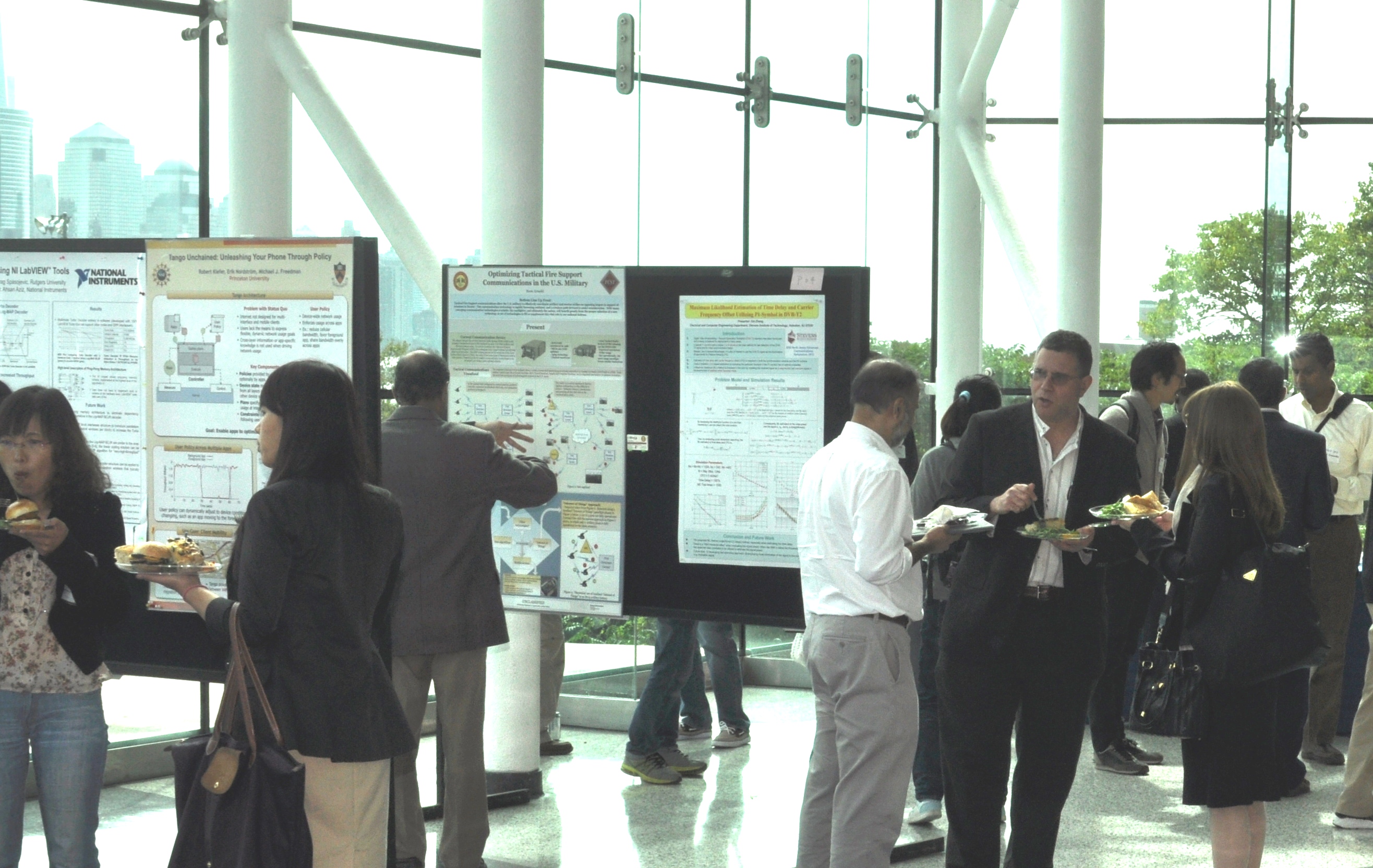
The poster presenters explain their results during lunch.
The symposium program started at 8.45 am with opening remarks from the symposium chair, Amit Patel, the IEEE North Jersey Section Chair, Russell Pepe, and Stevens Institute of Technology Vice-Provost Dr. Constantin Chassapis. Program Chair, Mani Iyer introduced the invited speakers for the morning session: Sundeep Rangan (NYU Poly) on millimeter wave picocellular wireless networks, Predrag Spasojevic (WINLAB, Rutgers) on the localization of packet-based radio transmitters in space, time, and frequency, Silvija Kokalj-Filipovic (WINLAB, Rutgers) on an efficient scheme for multi-media broadcast multicast services and its analysis, and Howard Huang (Bell Laboratories, Alcatel-Lucent) on a throughput-optimal communication strategy for the wireless random access channel. During lunch, there was ample time for discussions with the participants and the poster presenters. The afternoon program was chaired by Nagi Naganathan and consisted of presentations by Tao Zhang (Cisco) on securing large-scale consumer vehicle networks, Geoffrey Smith (Proxim Wireless) on WIFI security, Krishnamurthy Raghunandan (MTA/New York City Transit) on cellular security, as well as a presentation by Professional Development speaker Bala Prasanna, which was made possible by IEEE-USA funding from membership dues. A summary of all presentations can be found at the end of this article.
In the closing remarks following the technical program, symposium chair Amit Patel introduced Stevens Professor Yu-Dong Yao, who announced the winners of the poster competition. The poster committee, chaired by Prof. Hong Man and further consisting of Frank Laslo, Irfan Lateef, Pitipana Sakarindr and Manu Malek, had evaluated the 18 posters by students from ARDEC, CUNY, FDU, NJIT, NYU-Poly, Princeton, Rutgers-WINLAB, and Stevens Institute of Technology. Prof. Yu-Dong Yao, on behalf of Poster Chair Prof. Hong Man, announced the poster prize winners:
First Place – Kuang Cai, Department of Electrical and Computer Engineering, Stevens Institute of Technology, for the presentation of the poster “Exploiting Outband Radiation for Channel Identification” (this was joint work with Hongbin Li and Joseph Mitola III).
Second Place − Mustafa Riza Akdeniz, Electrical and Computer Engineering Department, NYU Poly, for the presentation of the poster “Millimeter Wave Picocellular System Evaluation for Urban Deployments” (this was joint work with Yuanpeng Liu, Sundeep Rangan, and Elza Erkip).
Third Place − Jie Tian, Computer Science Department, New Jersey Institute of Technology, for the presentation of the poster “Scheduling Survivability-Heterogeneous Sensor Networks for Critical Location Surveillance” (this was joint work with Tan Yan and Guiling Wang).
All poster presenters received a certificate. The winners received a poster award certificate as well as a check of $ 400, $ 300, and $ 200, respectively.
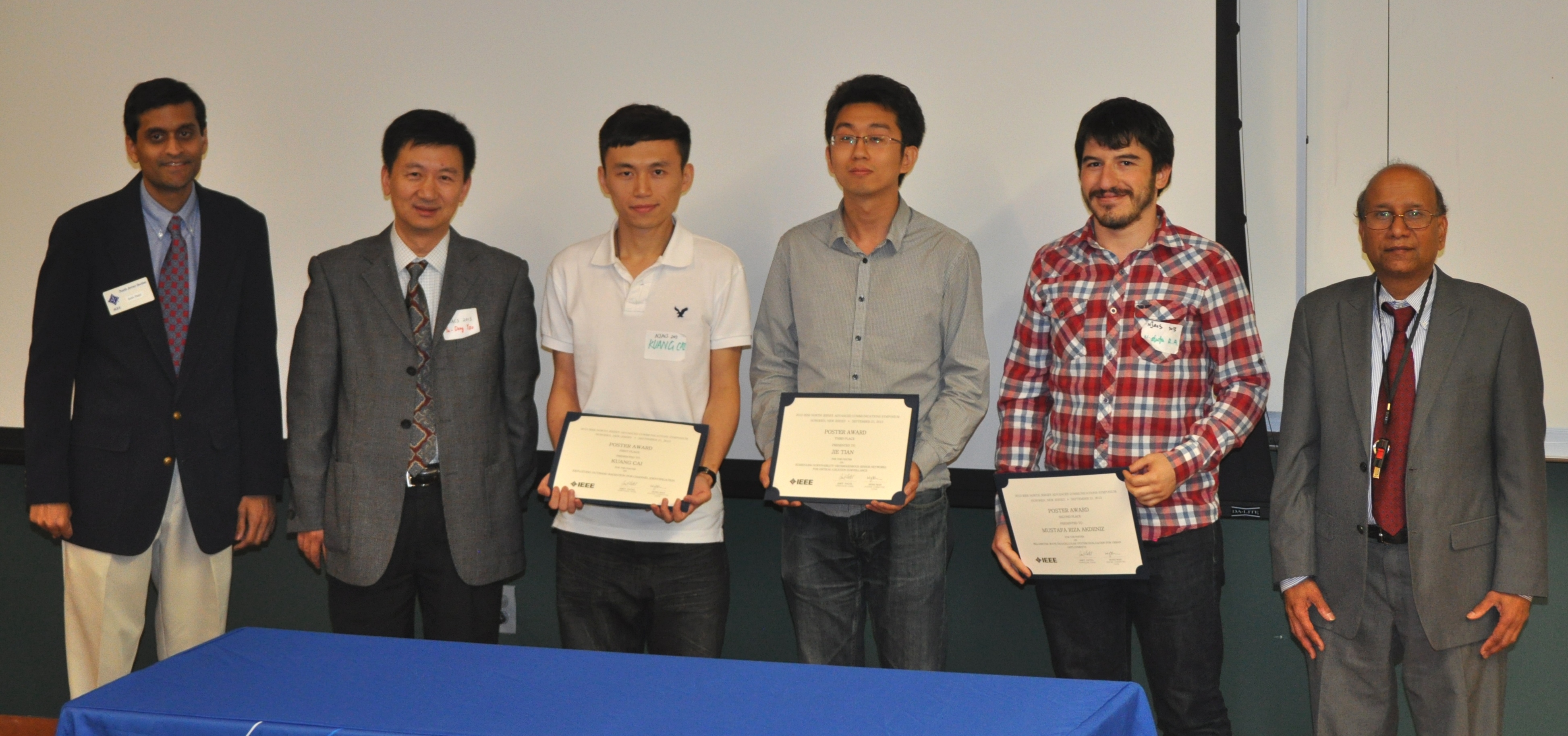
Poster winners and symposium organizers − from left to right: Amit Patel, symposium chair, Yu-Dong Yao, local arrangements chair, Kuang Cai, Stevens Institute of Technology (poster award, first place), Jie Tian, NJIT (poster award, third place), Mustafa Riza Akdeniz, NYU-Poly (poster award, second place), and Mani Iyer, program chair.
In his closing remarks, Amit Patel thanked Stevens Institute of Technology for hosting the symposium and for the use of the Babbio Center, which proved to be an excellent venue for this symposium; the auditorium had the right size and was well equipped, and the unobstructed view of the New York skyline across the Hudson during the breaks was impressive. Amit Patel further thanked several IEEE organizations for financial and organizational support: the IEEE North Jersey Section and its Communications and Vehicular Technology Chapters, who had received additional financial support from the IEEE Communications Society and the Vehicular Technology Society, and the Computer Chapter, as well as the IEEE New Jersey Coast Section’s Computer, Communications, and AP/VTS/EMC Chapters. The symposium further received IEEE USA PACE Technical Chapter support.
Amit Patel further thanked all co-organizers and volunteers for their hard work that made the symposium a success. He thanked Mani Iyer, Program Chair and IEEE North Jersey Vehicular Technology Chapter Chair, Hong Man, Poster Committee Chair and the Poster Committee members Frank Laslo, Irfan Lateef, Pitipana Sakarindr and Manu Malek. He further thanked Yu-Dong Yao, Local Arrangements, and Jennifer Chen, for her help at the venue, Michael Newell, Registration Chair as well as Cheng Zheng, Yu Zhou, and Zhen Ni for all their help at the registration desk, the event coordinators Nagi Naganathan and Hannah Zhou, and Adriaan van Wijngaarden, Publicity, and volunteers from the IEEE New Jersey Coast Section: Krishnna Raghunandan (Section Chair, Speaker), Newman Wilson (Communications Society Chair), Frank Laslo (Section Secretary, ComSoc Membership Development), Kit August (Women in Engineering), Filomena Citarella (Joint AP/VT/EMC Chapter Chair) and Irfan Lateef (ComSoc Chapter Vice-Chair).
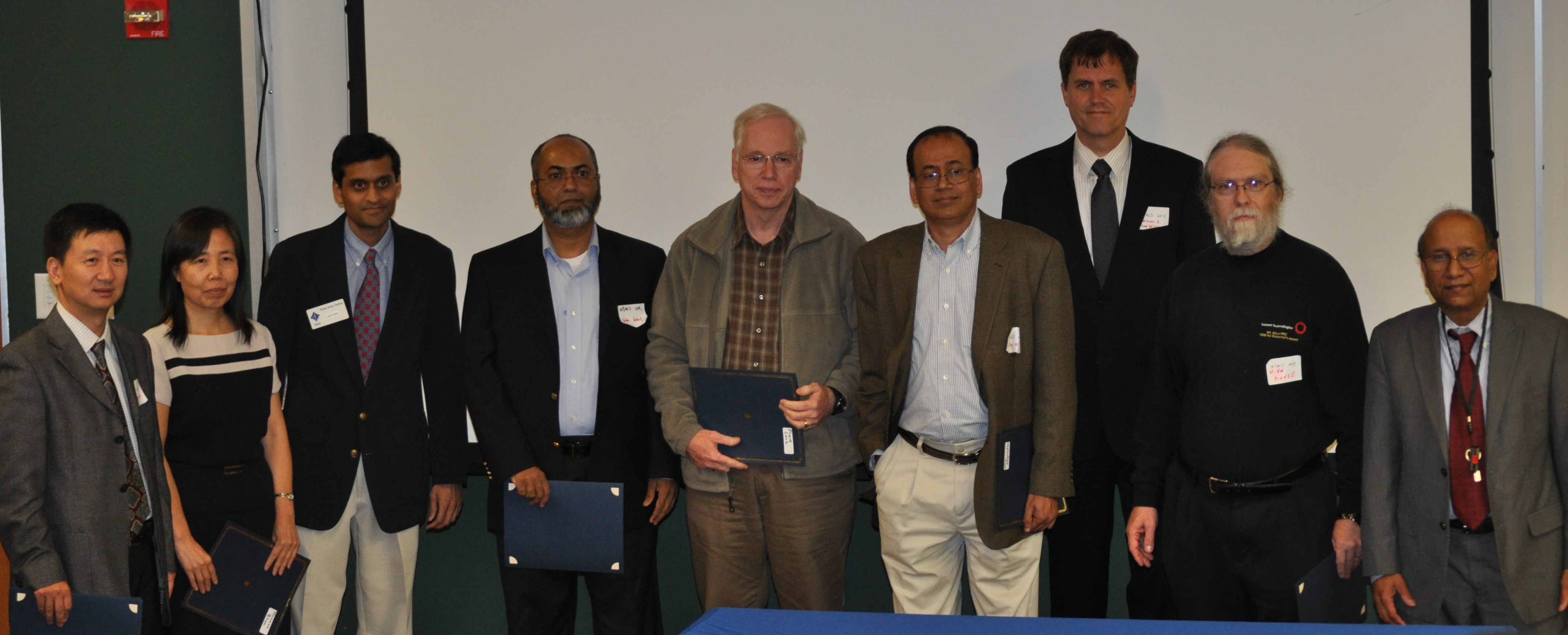
NJACS organizers and volunteers, from left to right: Yu-Dong Yao, Hannah Zhao, Amit Patel, Irfan Lateef, Frank Laslo, Nagi Naganathan, Adriaan van Wijngaarden, Michael Newell, and Mani Iyer.
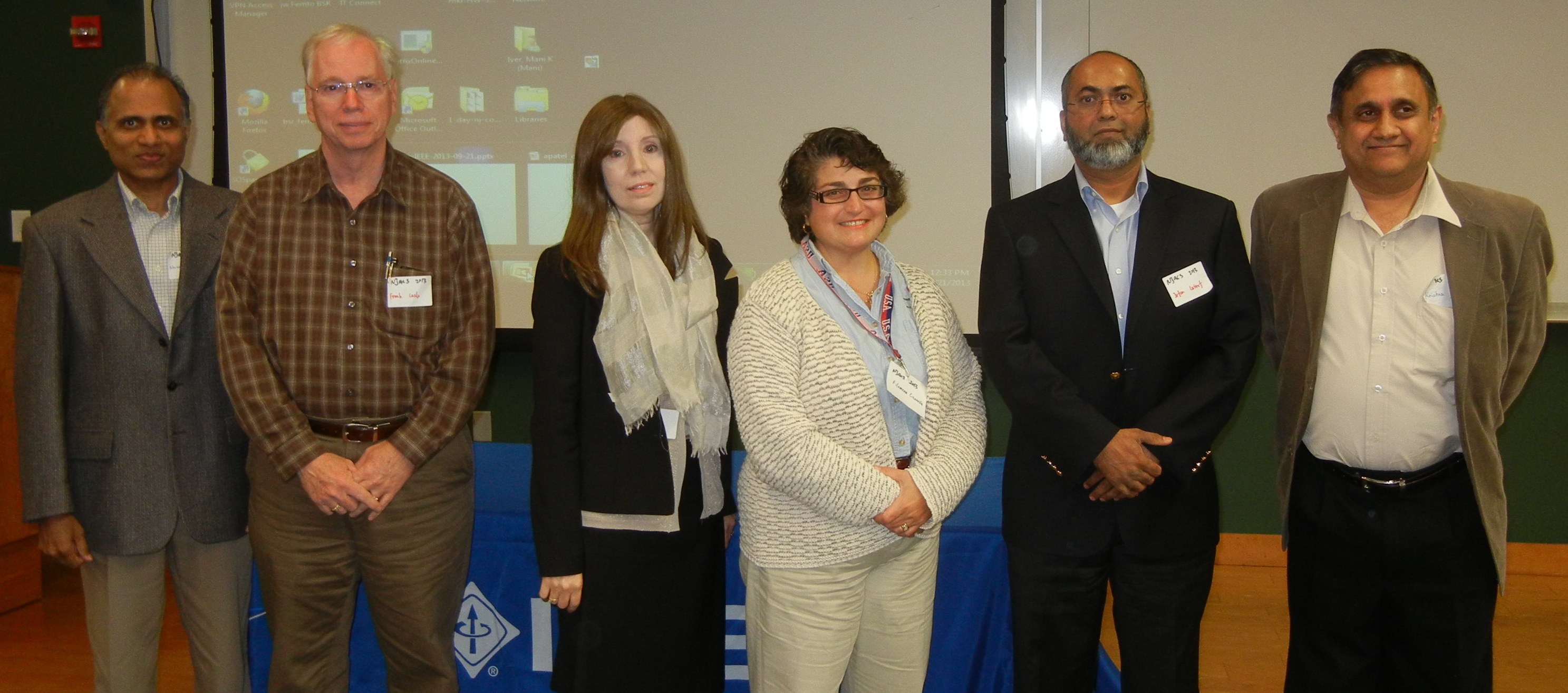
IEEE NJ Coast Section volunteers, from left to right: Newman Wilson, Frank Laslo, Kit August, Filomena Citarella, Irfan Lateef, and Krishnna Raghunandan (Raghu).
Contact information, pictures, and slides of the presentations can be found below.
Please contact the organizing committee or volunteers for any additional follow up questions or feedback on the event.

NJACS speakers and organizers, from left to right: Mani Iyer, Tao Zhang, Sundeep Rangan, Predrag Spasojevic, Howard Huang, Silvija Kokalj-Filipovic, Krishna Raghunandan (Raghu), Amit Patel and Nagi Naganathan.
Symposium Program
| 08:00-08:45 | Registration, Meet and Greet | |
| 08:45-09:00 | Opening Remarks | |
| Amit Patel, Symposium Chair and IEEE Communication Chapter Chair | ||
| 09:00-09:45 | Beyond 4G: Millimeter Wave Picocellular Wireless Networks | |
| Prof. Sundeep Rangan, NYU Poly | ||
| 09:45-10:30 | Localization of Packet-Based Radio Transmitters in Space, Time and Frequency | |
| Prof. Predrag Spasojevic, Rutgers, WINLAB | ||
| 10:30-10:45 | Coffee Break | |
| 10:45-11:30 | Low Complexity Doped Wireless Broadcast for Multimedia Applications | |
| Dr. Silvija Kokalj-Filipovic, Rutgers, WINLAB | ||
| 11:30-12:15 | Throughput-Optimal Communication Strategy for the Wireless Random Access Channel | |
| Dr. Howard Huang, Bell Laboratories, Alcatel-Lucent | ||
| 12:15-13:30 | Lunch and Poster Sessions | |
| 13:30-14:15 | Securing Large-Scale Consumer Vehicle Networks | |
| Dr. Tao Zhang, Cisco | ||
| 14:15-15:00 | WIFI Security | |
| Geoff Smith, Proxim | ||
| 15:00-15:15 | Coffee Break | |
| 15:15-16:00 | Cellular Security | |
| Dr. Krishna Raghunandan, MTA/New York Transit | ||
| 16:00-16:45 | Your Career – Don’t Let It Manage You – A Few Tips to Manage Career Security | |
| Bala Prasanna, IBM | ||
| 16:45-17:00 | Closing Remarks | |
| 17:00-17:45 | Reception and Networking | |
Summaries of the Invited Presentations
Sundeep Rangan, an Associate Professor at the ECE Department of NYU Poly, presented material on millimeter wave picocellular wireless networks and the prospects of using millimeter wave (mmW) frequencies between 30 GHz and 300 GHz for next-generation micro- and picocellular wireless networks. The mmW bands offer orders of magnitude greater spectrum than current cellular allocations and enable very high-dimensional antenna arrays for further gains via beamforming and spatial multiplexing. However, the propagation of mmW signals in outdoor non-line-of-sight (NLOS) links remains challenging and the feasibility of wide-area mmW cellular networks is far from clear. Recent, real-world measurements at 28 GHz in New York City were used to provide a realistic assessment of mmW picocellular networks in a dense urban deployment. It was found that, even under conservative propagation assumptions, mmW systems with cell radii of 100 m can offer an order of magnitude increase in capacity over current state-of-the-art 4G cellular networks with similar cell density. However, it was also shown that such mmW networks may operate in a largely power-limited regime where the full spatial and bandwidth degrees of freedom are not fully utilized. This power-limited regime contrasts significantly with current bandwidth-limited cellular systems. In addition, the wide bandwidths and use of high-dimensional antenna arrays impose significant power and processing constraints in the RF front-ends. Various research questions were posed related to designing cellular systems with these limitations. This was joint work with Prof. Elza Erkip and Prof. Ted Rappaport. For more information on this topic, please check: http://arxiv.org/abs/1304.3963.
Presentation: [pdf].
Predrag Spasojevic, an Associate Professor at WINLAB, ECE Department, Rutgers University, considered the localization of packet-based radio transmitters in space, time, and frequency in a scenario where one or more sensors observe a frequency band that is potentially used by multiple radio transmitters. The development of algorithms that analyze the signals detected at the sensors to estimate spectrum usage in space, time, and frequency was discussed. The proposed algorithms can be used for achieving efficient spectrum utilization by identifying unused portions of the spectrum in space, time and frequency as well as for other applications requiring spectrum monitoring. This was joint work with Goran Ivkovic and Ivan Seskar.
Presentation: [pdf].
Silvija Kokalj-Filipovic, an Assistant Research Professor at WINLAB, ECE Department, Rutgers University, considered multi-media broadcast multicast services (MBMS), which is a point-to-multipoint interface specification for existing and next-generation cellular networks. In the presentation, an efficient application layer coding scheme was presented that is suitable for the time-limited wireless broadcast framework of the MBMS standards. The scheme, referred to as doped broadcast, is based on Fountain codes and uses feedback to control the trade-off between reconstruction delay, broadcast overhead and decoding time/complexity. The doped broadcast scheme performs a limited-time broadcast followed by an individualized repair phase to ensure (possibly prioritized) quality of service (QoS) to most users. The goal of this two-phase scheme is not to improve on any particular performance metric where highly optimized standard recommendations already perform exceptionally well, but rather to enable flexible and transparent mechanisms to implement and control trade-offs between different performance metrics. Toward this goal, an analytically tractable model was developed for doped broadcast with ideal soliton-based codes providing repair strategy parameter estimation. The impact that inactivation and doping mechanisms employed by the decoder have on the complexity and overhead metrics was quantified and discussed for the proposed model. This approach guides a practical design tradeoff, which is important in today’s highly heterogeneous environments requiring individualized QoS. This was joint work with Predrag Spasojevic and Emina Soljanin.
Howard Huang, a Distinguished Member of Technical Staff at Bell Laboratories, Alcatel-Lucent, presented a throughput-optimal communication strategy for the wireless random access channel. A wireless time-slotted random access channel was considered where user arrivals are characterized by a Poisson process. Each user comes with a fixed payload, which has to be transmitted in the slot in which it arrives. If the transmission is successful, the user leaves the system, else it is dropped. The receiver and users are assumed to have knowledge of the arrival rate, but they are not aware of the actual number of users simultaneously attempting to communicate during a given time slot. In contrast to a conventional slotted ALOHA-based strategy where the channel is partitioned into orthogonal sub-channels and each user communicates on a randomly chosen sub-channel, a novel strategy is proposed whereby users transmit simultaneously over the entire channel resource and the receiver jointly decodes the transmissions. Under the proposed strategy, neither users nor the receiver have prior knowledge of the active user set, and it is shown that this is optimal in terms of maximizing the average throughput among all uncoordinated strategies. Numerical results showed that the proposal provides an order of magnitude throughput improvement compared to slotted ALOHA in a single-cell environment under a 5% maximum outage constraint. This was joint work with Harpreet Dhillon, Harish Viswanathan and Reinaldo Valenzuela.
Tao Zhang, the Chief Scientist for Smart Connected Vehicles at Cisco Systems, provided an overview of the integration of numerous communication devices in vehicles and their associated security risks. Vehicles are equipped with a wide variety of wireless and wired communication modules including modules for control, monitoring, diagnostics, access, authentication and connection with consumer devices. Additional modules and networks are being deployed and under continuous development, such as vehicle-to-vehicle (V2V) communications, in-vehicle internet connectivity and in-vehicle WiFi hotspots. Researchers and hackers have publicized vehicle security vulnerabilities related to remote key access and vehicle diagnostics, which highlighted the need for enhanced security protection for future vehicles as they become increasingly connected. The presentation analyzed some of the security challenges and discussed possible solutions that would meet many vehicle-specific requirements. Any solution must be highly scalable to support each automaker, millions of new vehicles each year, tens of millions of vehicles in operation, tens to over a hundred devices on each vehicle, and many more spare parts. Security operations, such as the provisioning and the subsequent update and reconfiguration of on-board security systems over time should be highly automated and should not require driver intervention. Vehicle security threat detections must be performed with extremely low error rates to minimize the probability of wrongfully blaming innocent vehicles and drivers. Any security capability placed on-board vehicles must be kept up to date over the vehicles’ long life-cycles without causing inconvenience to vehicle owners and in ways that does not consume excessive wireless bandwidth.
Geoffrey Smith, Vice-President of Proxim Wireless, discussed WIFI security. With increased use of the Internet by the public and corporations, attacks have become more sophisticated. Service and application providers often wonder where and how attacks can be deterred. This presentation addressed the challenges from cyber attackers for whom access through Wi-Fi seems straightforward and discussed typical prevention methods in the traditional IP world.
Presentation: [pdf].
Krishnamurthy Raghunandan (Raghu), a Construction Administrator at the MTA/New York City Transit, gave a presentation on security in cellular systems. Cellular security is an ever changing area that originated during mid-1990s in response to wide spread fraud. This presentation provided an overview of how security is achieved using intimate interaction over the radio physical and MAC layers, and it compared and contrasted these techniques with traditional techniques used in IP networks.
Presentation: [pdf].
Bala Prasanna, a Program Manager at IBM, gave a presentation on career management: Manage Your Career – Don’t Let it Manage You – a Few Tips to Manage Career Security. While no one can give job security, one can strive for career security through career growth. An important component of career growth is learning and practicing soft skills, and realizing that workplace habits and expectations have changed significantly in the last few years. Surviving and thriving depends on the ability to grasp the broader picture and hone some essential skills. This presentation offered a lot of tips to be relevant and successful in today’s workplace.
Presentation: [pdf].
Symposium Flyer
A one-page symposium flyer can be downloaded here: [pdf].
Call for Posters
A one-page Call for Posters can be downloaded here: [pdf].
